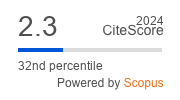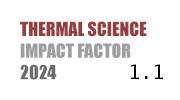THERMAL SCIENCE
International Scientific Journal
Thermal Science - Online First
online first only
Development and validation of a cryogenic hydrogen vapor dispersion model with integrated risk assessment framework for accident scenarios in hydrogen refueling infrastructure
ABSTRACT
With the widespread application of hydrogen energy as a clean energy source, its safety issues are increasingly being emphasized. Hydrogen leakage can lead to fires or explosions, posing a threat to public safety. Conducting safety research on the diffusion patterns of liquid hydrogen leakage in response to this safety issue can help prevent and reduce hydrogen leakage accidents and protect people's lives and property. This study employs the computational fluid dynamics (CFD) software Fluent, in combination with the Lee model and the VOF model, to simulate the leakage and vaporization process of liquid hydrogen. It is found that an increase in wind speed extends the downwind diffusion distance and reduces the vertical height. Based on the diffusion patterns of the combustible gas cloud and in view of the limitations of hydrogen sensors, a new method of using temperature sensors to monitor environmental temperature changes to predict hydrogen concentration is proposed. By analyzing the mathematical relationship between temperature and hydrogen concentration during the initial stage of leakage, a mathematical model is established. The validation of the model shows that temperature sensors arranged on the 0.8 m height plane can quickly respond to leakage events, thereby enhancing the safety management level of hydrogen refueling stations.
KEYWORDS
PAPER SUBMITTED: 2025-02-17
PAPER REVISED: 2025-03-24
PAPER ACCEPTED: 2025-03-31
PUBLISHED ONLINE: 2025-07-05
- LI, J. F., et al., Diffusion features of jet leakage with liquid hydrogen in large space, CIESC Journal, 73 (2022), 11, 5177-5185
- Witcofski, R. D., Chirivella, J. E., Experimental and analytical analyses of the mechanisms governing the dispersion of flammable clouds formed by liquid hydrogen spills, International Journal of Hydrogen Energy, 9 (1984), 5, 425-435
- Statharas, J. C., et al., Analysis of data from spilling experiments performed with liquid hydrogen, Journal of Hazardous Materials, 77 (2000), 1-3, 57-75
- Hooker P, et al. Experimental releases of liquid hydrogen[C]. International Conference on Hydrogen Safety, (2011)
- Xiao, J. S., et al., Computational fluid dynamics model based artificial neural network prediction of flammable vapor clouds formed by liquid hydrogen releases, International Journal of Energy Research, 46 (2022), 8, 11011-11026
- Zhou, C. L., et al., Optimizing hydrogen refueling station layout based on consequences of leakage and explosion accidents, International Journal of Hydrogen Energy, 54 (2024), 817-836
- Xiao, J. J., et al., GASFLOW-MPI: A new 3-D parallel all-speed CFD code for turbulent dispersion and combustion simulations: Part I: Models, verification and validation, International Journal of Hydrogen Energy, 42 (2017), 12, 8346-8368
- Middha, P., Hansen, O. R., Using computational fluid dynamics as a tool for hydrogen safety studies, Journal of Loss Prevention in the Process Industries, 22 (2009), 3, 295-302
- Wang, F. N., et al., Deterministic risk assessment of hydrogen leak from a fuel cell truck in a realscale hydrogen refueling station, International Journal of Hydrogen Energy, 50 (2024), 1103- 1118
- Pu, L., et al., Plume dispersion behaviour and hazard identification for large quantities of liquid hydrogen leakage, Asia‐Pacific Journal of Chemical Engineering, 14 (2019), 2, e2299
- Tang, X., et al., Dispersion behavior and safety study of liquid hydrogen leakage under different application situations, International Journal of Hydrogen Energy, 45 (2020), 55, 31278-31288
- Giannissi, S. G., Venetsanos, A. G., A comparative CFD assessment study of cryogenic hydrogen and LNG dispersion, International Journal of Hydrogen Energy, 44 (2019), 17, 9018-9030
- Giannissi, S. G., Venetsanos, A. G., Study of key parameters in modeling liquid hydrogen release and dispersion in open environment, International Journal of Hydrogen Energy, 43 (2018), 1, 455- 467
- Giannissi, S. G., et al., On the CFD modelling of hydrogen dispersion at low-Reynolds number release in closed facility, International Journal of Hydrogen Energy, 46 (2021), 57, 29745-29761
- Giannissi, S. G., et al., CFD modeling of hydrogen dispersion under cryogenic release conditions, International Journal of Hydrogen Energy, 39 (2014), 28, 15851-15863
- Mao, X. B., et al., Simulation and analysis of hydrogen leakage and explosion behaviors in various compartments on a hydrogen fuel cell ship, International Journal of Hydrogen Energy, 46 (2021), 9, 6857-6872
- Jiang, Y., et al., Optimized deployment method and performance evaluation of gas sensor network based on field experiment, Journal of Ambient Intelligence and Humanized Computing, 12 (2021), 729-744
- Qian, J. Y., et al., A numerical study of hydrogen leakage and diffusion in a hydrogen refueling station, International Journal of Hydrogen Energy, 45 (2020), 28, 14428-14439
- Bellegoni, M., et al., Optimization of gas detectors placement in complex industrial layouts based on CFD simulations, Journal of Loss Prevention in the Process Industries, 80 (2022), 104859
- Sklavounos, S., Rigas, F., Fuel gas dispersion under cryogenic release conditions, Energy & Fuels, 19 (2005), 6, 2535-2544
- Dong, J. K., et al., Impact analysis of multi-sensor layout on the source term estimation of hazardous gas leakage, Journal of Loss Prevention in the Process Industries, 73 (2021), 104579
- Dong, J. K., et al., Optimization of sensor deployment sequences for hazardous gas leakage monitoring and source term estimation, Chinese Journal of Chemical Engineering, 56 (2023), 169-179
- Tanaka, T., et al., Experimental study on hydrogen explosions in a full-scale hydrogen filling station model, International Journal of Hydrogen Energy, 32(13) (2007), 2162-2170. doi.org/10.1016/j.ijhydene.2007.04.019
- Shirvill, L. C., et al., Safety studies on high-pressure hydrogen vehicle refueling stations: Releases into a simulated high-pressure dispensing area, International Journal of Hydrogen Energy, 37(8) (2012), 6949-6964. doi.org/10.1016/j.ijhydene.2012.01.030
- Kikukawa, S., Consequence analysis and safety verification of hydrogen fueling stations using CFD simulation, International Journal of Hydrogen Energy, 33(4) (2008), 1425-1434. doi.org/10.1016/j.ijhydene.2007.11.027
- Kim, E., et al., Simulation of hydrogen leak and explosion for the safety design of hydrogen fueling station in Korea, International Journal of Hydrogen Energy, 38(3) (2013), 1737-1743. doi.org/10.1016/j.ijhydene.2012.08.079
- Idris, A. M., et al., A fuzzy multi-objective optimization model of risk-based gas detector placement methodology for explosion protection in oil and gas facilities, Process Safety and Environmental Protection, 161 (2022), 571-582. doi.org/10.1016/j.psep.2022.03.001
- Zhang, Y., et al., Progress and prospects of research on hydrogen sensors, Chinese Science Bulletin, 68(Z1) (2023), 204-219
- Gao, Y., et al., Effects of leakage location and ventilation condition on hydrogen leakage during shipping of fuel cell vehicles, International Journal of Hydrogen Energy, 54 (2024), 1532-1543. doi.org/10.1016/j.ijhydene.2023.12.095
- Pu, L., et al., Numerical investigation on the difference of dispersion behavior between cryogenic liquid hydrogen and methane, International Journal of Hydrogen Energy, 44(39) (2019), 22368-22379. doi.org/10.1016/j.ijhydene.2019.05.219

